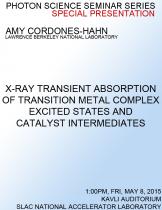SLAC, Kavli Auditorium
Speaker: Amy Cordones-Hahn, LBNL
Program Description
Transition metal complexes have proven useful as dyes and photocatalysts because their reduction potential and oxidation state can be tuned by ligand modification. X-ray transient absorption studies resonant with the central metal atom have illuminated the changes in charge density, spin state, coordination geometry, and bond lengths that occur in the excited states of such complexes. The complete picture of correlated electronic transitions and atomic rearrangements obtained in such studies is essential to understanding the charge transfer and reaction pathways that determine the light harvesting and catalytic functions of transition metal complexes. Here, I will present the results of x-ray transient absorption experiments with energies resonant with the central metal and ligand atoms of a Ruthenium(II) polypyridyl sulfoxide-containing photochromic switch, which undergoes ligand isomerization from an S-bonded to an O-bonded form upon photoexcitation. By monitoring isomerization from both the Ru L-edge and S K-edge perspectives we are able to simultaneously determine the spin state and the degree of Ru-S interaction in real time. Our results highlight the important role of metal-centered states in the isomerization of Ru-sulfoxides and a detailed kinetic mechanism is suggested for such photochromic complexes. To conclude I will summarize my proposed research plan to extend x-ray transient absorption methods to multicomponent photocatalytic solutions. Such studies will identify catalytic intermediates by resolving changes in oxidation state and coordination geometry at the metal center. The complete mechanistic understanding of these complicated multi-step catalytic reactions enabled by identifying reactive intermediates will facilitate the rational design of more active and selective transition metal catalysts.





